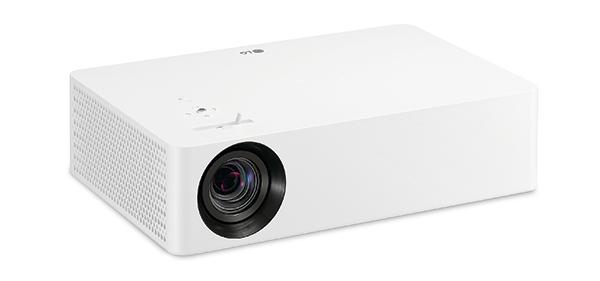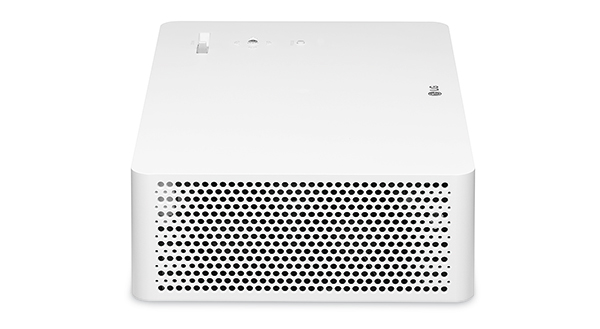LG HU70LS 4K LED projector review

The LG Cinebeam HU70LS is smarter than the average 4K home theatre projector... in every sense.
Most obviously, it’s far more presentable. Rather than reflect the boardroom style of its peers, the case is trendy white with sharp lines and discreet vents left and right of the offset lens.
And at just 3.2kg, this Cinebeam is a relatively easy model to ceiling mount, although most users will simply place it on a coffee table as and when they want to use it.
It’s also smart in the connected sense. The HU70LS is built around LG’s much-liked WebOS smart TV platform, here in its v4.5 iteration. A familiar fixture on LG’s flatscreen TVs, it offers much of the same functionality. So is this the bigscreen beamer we’ve all been waiting for?
LG HU70LS setup and features
Connectivity is good enough. To the rear are two HDMI
v2.0 inputs, one of which is ARC enabled, plus two USB ports, a digital audio optical output and headphone jack. Ethernet is available, offering a wired alternative to Wi-Fi and Bluetooth.
Getting up and running is a doddle, although a lack of image shifting (beyond digital keystone correction) means you'll want to be as square-on as possible. Zoom and focus adjustment controls are manual.
In use, the experience is definitely more smart TV
than conventional projector, which immediately makes
it a slicker proposition than most rival home cinema PJs.
Calling up the WebOS interface reveals a familiar launchbar with web browser, photo, video and music players, plus a file viewer for connected USB devices. An input menu offers a quick click to HDMI and USB sources.
You can also connect your smartphone to the projector via Bluetooth to play music through the LG's integrated sound system – although, to be honest, listening to Biffy Clyro via the HU70LS is only marginally better than eavesdropping someone else's headphones.
LG HU70LS performance
The projector takes a fresh approach to LED, combining red, green and blue diodes with a fourth so-called Dynamic Green LED, which is used to boost image brightness and contrast. This four-channel application is a significant
step up from conventional RGB LED devices, and pays dividends onscreen.
And given that this LG is built around an LED light engine, there’s no need for a colour wheel, and consequently, there’s no characteristic rainbow effect. Pictures are clean and coherent, without irritating colour fringing seen around areas of high contrast. LG also says the technology is not subject to age discolouration.
Another benefit of the LED engine is longevity. With
a working life of 30,000 hours, this projector should see you through a complete showing of The Irishman, including credits, and remain essentially maintenance-free during
its lifetime.
The HU70LS boasts 4K resolution, courtesy of Texas Instruments’ crafty (and not native 4K) DLP mirror flipping technology, as well as HDR10 support, although the
value of the latter is negligible.
As is nearly always the way with projectors, the HDR experience is never comparable to what we’re used to seeing on flatscreen TVs, not least because there’s no precise pixel control.
The Boys (Amazon Prime, 4K HDR) is notable for some wonderful HDR grading, but it’s difficult to appreciate here, thanks to the PJ's subdued overall contrast. When Homelander wipes out the Syrian Compound V factory,
it's only his glowing-red heat vision eyes that make a specular impression. Shadow detail is lost in a fog of grey.
Dynamic Contrast adjustments can help, giving images a little more bite, but improvements are subtle at best.
Since their introduction, we’ve noted different
visual performances from TI’s various 4K micromirror devices, and here the faux UHD mirror-flipping doesn’t really convince at all. Test patterns reveal very little
fine detail information that would be indicative of
a native 2160p picture, and there’s a smidge of grit to
its replication.
So in terms of resolution, some might describe what’s onscreen as more akin to HD-plus. That said, the universal impression is of a cinematic presentation, and the sheer vibrancy and solidity of its colours is a treat. This is an obvious advantage of LED. Despicable Me 3 (Blu-ray)
is a veritable Skittle bag of rich hues.
There’s the usual selection of image presets for different content types (Standard, Cinema, Sports,
Game, HDR Effect, Expert Bright Room and Expert Dark Room), along with five HDR-centric presets. For most content, I found the Standard and Cinema image options did an entirely acceptable job, but if you want to delve deeper you can. 'Expert' tweaks include adjustable gamma, colour management and the aforementioned Dynamic Contrast, which can be set to Low, Medium
or High.
One more obvious image foible
is HD upscaling, which is largely unimpressive. 1080p sources exhibit clear jaggies on verticals, with buildings often taking on the appearance of steps.
Yet when it comes to motion handling, LG’s TruMotion interpolation (available in Smooth, Clear or User modes) does a suitably icy job. It’s worth experimenting to find a setting you like when it comes to sports or broadcast TV, but for movies I’d almost certainly opt to turn it off.
Operating noise amounts to a constant low-level
hum, peaking at around 30dB but never too distracting.
A dedicated home cinema sound system should cover
it up; the HU70LS has that modest audio system of its own
onboard, but at just 2 x 3W it’s hardly going to suffice for
a movie night.
LG HU70LS verdict
Don’t buy this beamer for its 4K HDR appellation
alone, though. Allow yourself to be persuaded more by
its bright-room clarity, vibrant colour fidelity and smart skills. It’s easy to imagine this model replacing a flatscreen TV altogether.
LG HU70LS
Price: £1,650
We say: Compact and solidly entertaining, and ideally suited for bright-room viewing. Just don't expect HDR thrills.
Overall: 4/5
3D: No
Features: DLP LED projector; 2 x 3W built-in audio; 30,000-hour claimed LED
lamp life; claimed 30dB fan noise; WebOS 4.5 smart platform; Bluetooth audio output; Wi-Fi; 1.2-1.5:1 throw ratio; TrueMotion motion processing; gamma, white balance and colour management; Dynamic Contrast; Dynamic Colour; HDR Effect; HDMI ARC; MiraCast

As you might suspect from its compact size, there’s no conventional lamp onboard. Instead the HU70LS uses an LED light engine. This has the benefit of instant on (and off), and I was just as swiftly impressed. The HU70LS is bright enough to be used in rooms with even quite high levels of ambient light – it's rated at 1,500 Lumens, but this seems to undersell its performance, and colour impact is pronounced. Chroma accuracy is said to be around 92 per cent of the DCI-P3 colour space.
Overall LG's HU70LS is a classy reinterpretation of the home cinema projector, but not quite an essential audition. I love its contemporary form factor and zero-maintenance LED light engine, and it’s very easy to live with.
HCC Verdict
www.lg.com/uk
Specification
4K: 3,840 x 2,160 via Texas Instruments' XPR technology
HDR: Yes. HDR: Yes. HDR10
Connections: 2 x HDMI inputs; digital optical audio output; 3.5mm headphone output; Ethernet; 2 x USB
Brightness (claimed): 1,500 Lumens
Contrast (claimed): 150,000:1
Zoom: Yes. 1.25x
Dimensions: 324(w) x 210(d) x 95(h)mm
Weight: 3.2kg
 |
Home Cinema Choice #351 is on sale now, featuring: Samsung S95D flagship OLED TV; Ascendo loudspeakers; Pioneer VSA-LX805 AV receiver; UST projector roundup; 2024’s summer movies; Conan 4K; and more
|























































